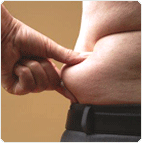How gastric banding works?

Bariatric surgery is now a days the most effective alternative to treat clinically severe obesity. The sleeve gastrectomy reduces the stomach capacity by means of a vertical mechanical suture that turns the stomach's natural shape of a bag into a tube. If you suffer from morbid obesity, consider bariatric surgery as the best option to improve your quality of life and enjoy your days with your beloved people.
What does a sleeve gastrectomy consist of ?
It is a restrictive procedure; by reducing the stomach capacity, the patient feels full after a small intake of food. It is advisable for people with a body mass index of 60 or more, since the risks of intra and post surgical complications for them is very high. In these cases, sleeve gastrectomy is performed before a gastric bypass. This is done so that the patient will weigh a lot less at the time of the bypass, reducing the risks of complications. It helps the patients reduce their weight considerably in 40% of the cases. If these patients also change their eating habits, they may not need a second surgery to complete the treatment. If it is necessary to resort to a second surgery, such as a bypass or a gastric band, the patient will have to wait 18 months. It may also be used as a first option of a restrictive procedure in patients of a BMI of between 45 and 60, if the medical assessment of the case determines so.
How is sleeve gastrectomy performed ?
It is done by means of laparoscopic techniques. These techniques involve the use of special instruments that are introduced through very small incisions that allow the area treated to be seen on a closed circuit monitor.The incisions that the surgeons make nowadays are of no more than 0.4 inches (1 cm); the surgical trauma they produce is much lower and the post surgical pain much more tolerable. Through these incisions, the surgeon can reach the stomach and, using a special stapler, he makes a vertical suture to divide the stomach in two. One of the sections is shaped like a tube that goes from the esophagus to the intestine. The other one is separated and removed. The staples used are very strong.
The Results
Bariatric surgery procedures have - generally - good results. Apart from losing weight, most of the patients recover physical and psychological health.
Before surgery : Tips
Before thinking about undergoing bariatric surgery, such as a sleeve gastrectomy, it is important for you to bear the following things in mind:
You must be at least 18 years old. Your obesity must not be due to other diseases that could be treated with other procedures. Your body mass index (BMI) should be over 40, or at least over 35 if you suffer from a disease related to morbid obesity. You must have lived at least 5 years with that BMI and failed in your attempts to lose weight by non-surgical treatments. Take your time to think about the important changes in your diet after a reduction of your stomach capacity. Get psychologically prepared to follow these new habits for the rest of your life. Bear in mind that you will not be able to drink large quantities of alcohol. If you are used to drinking a lot of alcohol, you may not be a good candidate for this surgery.
After surgery : Tips
Hospitalization
3 or 4 days (1 day in intensive care unit and 2 or 3 days in the recovery room)
Bandages
You will have small adhesive strips on each of the incisions of 0.4 inches (1 cm). You will also have two drainage tubes connected to airtight plastic bottles, one of which will be removed on the third day after the surgery and the other on the seventh day.
Amount of pain
Mild to moderate.
Scars
Seven scars of only 0.4 inches (1 cm) will be distributed on your abdomen in the shape of a diamond; its lower vertex will be on the navel and the upper one at the base of the breastbone.
Removal of the stitches
7 to 10 days after the surgery.
Recovery
At first, you will feel discomfort on the abdominal area, but very oon the pain will become milder.
Risks and complications of vertical gastroplasty
Every surgical procedure, regardless of its triviality, has some risks and we should always think of them as a possibility. Gastric bypass is a major surgical procedure and it is certainly not against this rule. The average percentage of immediate post surgical complications is about 2%.
The main complications are :
Acid reflux. The sutures (staples) may open or there may be leakage through them. Hemorrhages where the incisions and/or sutures have been made. Intestinal obstruction. Blood clots may form on the legs or other parts of the body and migrate to the lungs, increasing the risk of pulmonary embolism. Breathing problems. As time goes by, the remaining portion of the stomach may stretch and partially recover its original capacity.
